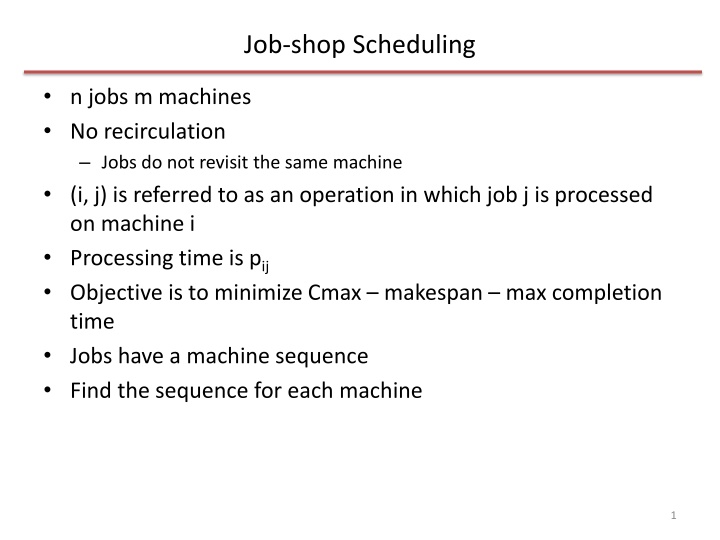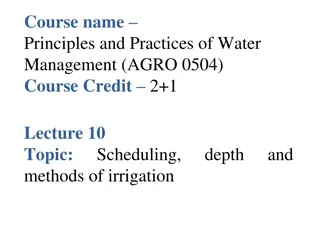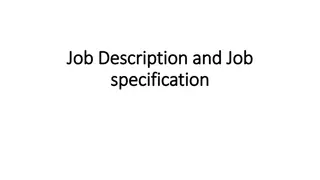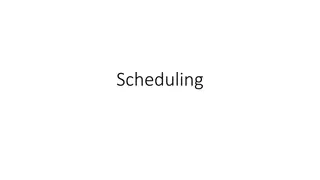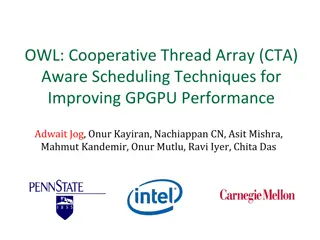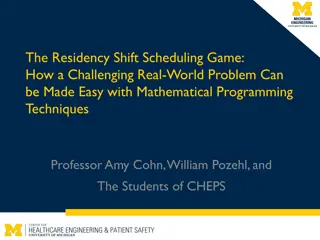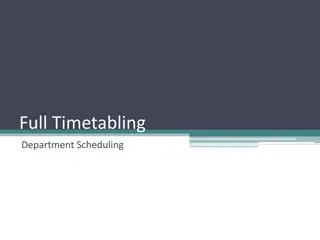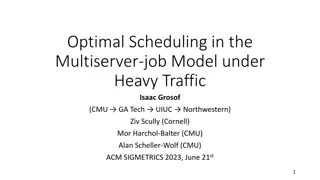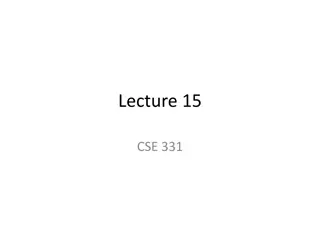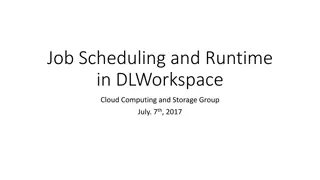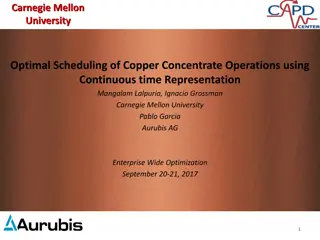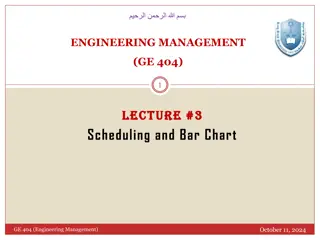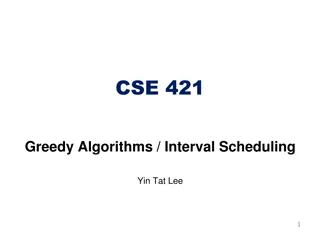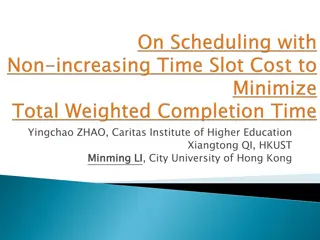Optimal Job Scheduling Techniques
This content explores various job scheduling scenarios, including job-shop scheduling, training matrix scheduling, and hospital sequencing. It discusses sequencing jobs on machines to minimize completion times, analogous to training schedules, and patient diagnostics in hospitals. Additionally, it covers solutions using branch and bound for job-shop scheduling and the importance of minimizing makespan for all jobs. The content includes images illustrating scheduling concepts and IP solutions for efficient job sequencing.
Download Presentation

Please find below an Image/Link to download the presentation.
The content on the website is provided AS IS for your information and personal use only. It may not be sold, licensed, or shared on other websites without obtaining consent from the author.If you encounter any issues during the download, it is possible that the publisher has removed the file from their server.
You are allowed to download the files provided on this website for personal or commercial use, subject to the condition that they are used lawfully. All files are the property of their respective owners.
The content on the website is provided AS IS for your information and personal use only. It may not be sold, licensed, or shared on other websites without obtaining consent from the author.
E N D
Presentation Transcript
Job-shop Scheduling n jobs m machines No recirculation Jobs do not revisit the same machine (i, j) is referred to as an operation in which job j is processed on machine i Processing time is pij Objective is to minimize Cmax makespan max completion time Jobs have a machine sequence Find the sequence for each machine 1
Training matrix analogous to Job shop Scheduling There are n trainees (jobs) There are m departments (machines) Each trainee has a pre-determined sequence based on their qualification Each trainee spends a different number of weeks in each department based on their final placements. Find a schedule that minimizes the completion time of all required training for this new batch of trainees. 2
Hospital sequencing Medical depts have equipment and doctors which are like the machines Jobs are patients, who are scheduled to arrive the next day. Each patient has a pre-determined sequence for testing and consultation based on their ailment Each patient spends a different amount of time in each medical department (with equipment, doctors) based on their ailment. Find a schedule that minimizes the completion time for all patient diagnostics and doctor consultations. 3
Job-shop Scheduling 4 m/c and 3 jobs Jobs j 1 2 3 m/c i seq 1 2 3 2 1 4 3 1 2 4 p22 = 8, p12=3, p42=5, p32=6 p13=4, p23=7, p43=3 pij p11=10, p21=8, p31=4 4
Job-shop Scheduling Conjunctive (solid arcs) and disjunctive (dotted arcs) Conjunctive machine sequence for a job Disjunctive job sequence for a machine 8 10 1,1 2,1 3,1 0 4 3 8 5 U 2,2 1,2 4,2 3,2 V 0 6 Sink Source 0 3 1,3 2,3 4,3 4 P23 =7 1 sink because the completion time of the last job is important to obtain minimum makespan Cmax to complete all jobs 5
Job-shop Scheduling IP solution Let yij be starting time of job j on machine i Minimize Cmax s.t. 1. ykj yij >= pij for all (i,j) (k,j) (for the job) 2. Cmax - yij >= pij for all (i,j) (for the job) 3. yij-yil >= pil or yil yij >= pij for all (i,l) and (i,j) i = 1 m (for the machine) 4. yij >= 0 Solve using branch and bound Computationally prohibitive for large n and m (see page 72 and 74 of text) 6
Shifting Bottleneck Heuristic Very efficient heuristic for n job m machine job shop with jobs having a pre-determined sequence Has been proven to be very close to optimal, which has been verified numerous times with the branch and bound optimal search. Proven to be very fast compared to B&B 7
Shifting Bottleneck Heuristic completion time M is the set of all machines Mo is the set of machines for which the sequence has been determined An iteration results in selecting a machine from M-Mo for inclusion in Mo. Each machine in M-Mo is considered as a single machine problem with release and due dates for which the maximum lateness is to be minimized (Lmax) Then the machine with the largest Lmax is chosen and is termed as a bottleneck. This is included in Mo Update Cmax = Cmax + Lmax Re-sequence all machines in Mo-the last machine added. Continue until M-Mo is a null set. Release date of job j on machine i is the longest path from source to node (i,j) Due date of job j on machine i is the longest path from node (i,j) to sink pij and the resultant is subtracted from Cmax of set Mo 8
Shifting Bottleneck Heuristic Gantt Chart J1 M1 M2 M3 10 18 22 J2 M2 M1 M4 M3 8 11 16 22 J3 M1 M2 M4 4 11 14 Slack 1 J1 J2 J3 M1 10 13 17 J2 J1 J3 M2 8 10 18 24 J2 J1 M3 18 22 28 M4 J2 J3 13 18 25 28 9 See handout for solution Slack 4
Composite Dispatching rules ATC Apparent tardiness cost ATCS Apparent tardiness cost with set up See page 446 10
Shifting Bottleneck Heuristic weighted tardiness M is the set of all machines Mo is the set of machines for which the sequence has been determined An iteration results in selecting a machine from M-Mo for inclusion in Mo. Each machine in M-Mo is considered as a single machine problem with release and due dates for which a priority index is calculated Iij(t) Iij(t) is computed using the ATC rule (Apparent Tardiness Cost) Sequence jobs on the machine with the highest to lowest Iij(t) Calculate weighted tardiness Then the machine with the largest weighted tardiness is chosen and is termed as a bottleneck. This is included in Mo Re-sequence all machines in Mo-the last machine added. Continue until M-Mo is a null set. Release date of job j on machine i is the longest path from source to node (i,j) Due date of job j on machine i is the longest path from node (i,j) to sink pij and the resultant is subtracted from Cmax of set Mo If a path does not exist then make it infinity. 11
Shifting Bottleneck Heuristic weighted tardiness Jobs 1 2 3 wj rj dj 1 5 24 1 2 3 2 0 18 2 0 16 m/c seq p11=5, p21=10, p31=4 p32 = 4, p12=5, p22=6 p33=5, p23=3, p13=7 pij 3 1 2 3 2 1 12
Shifting Bottleneck Heuristic weighted tardiness 3 sinks because the completion time of all jobs is important 4 10 5 1,1 2,1 3,1 V 5 Sink 6 5 4 U 3,2 1,2 2,2 V 0 Sink Source 0 7 5 P23 =3 3,3 2,3 1,3 V Sink See handout for solution 13
Shifting Bottleneck Heuristic weighted tardiness ATC Rule: ? ???+??? ?,0 ? ? ?? ??? exp( max ??? ? ???? = ?=1 ) t is the earliest time at which machine i can be used K is a scaling parameter ? is the average processing time for machine i Weighted Tardiness ????" ?? exp( max ?? ??", 0 Ck is the completion time of job k at the beginning of an iteration Ck is the new completion time of job k at the end of an iteration ? = ?=1 ) ? 14
Software for Job shop scheduling LEKIN Summary Single machine scheduling With or without setup time Parallel machines (machines can process all jobs) Flow shop (All jobs have to flow first on one machine and then on another) Job-shop Minimize Completion time Minimize Weighted Tardiness Flexible flow shop Methods Dispatching rules, Tabu, Simulated Annealing, Shifting bottleneck heuristics for completion time and weighted tardiness objective. 15
